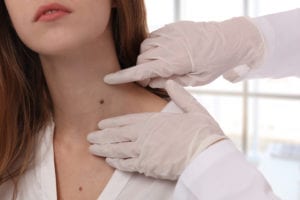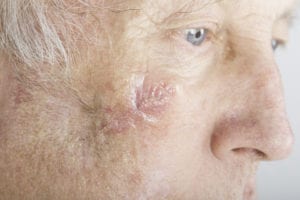Patient FAQs
Is Mohs surgery the best treatment option for all skin cancers?
 If you have any type of suspicious skin lesion you should seek evaluation by a dermatologist. If skin cancer is suspected, he or she may recommend and perform a biopsy. Mohs surgery may be recommended based on the type and location of the skin cancer, as well as other factors. If your dermatologist does not perform this technique, he or she will be able to refer you to a Mohs surgeon in your area.
If you have any type of suspicious skin lesion you should seek evaluation by a dermatologist. If skin cancer is suspected, he or she may recommend and perform a biopsy. Mohs surgery may be recommended based on the type and location of the skin cancer, as well as other factors. If your dermatologist does not perform this technique, he or she will be able to refer you to a Mohs surgeon in your area.
Patients attempting to locate a Mohs surgeon on their own may elect to use the Surgeon Locator. Some members may have their own patient information pamphlets that summarize their Mohs training, experience, and practice information.
How Effective is Mohs Micrographic Surgery?
The Mohs procedure is widely considered the most effective treatment for many basal cell and squamous cell carcinomas. During the treatment process, 100 percent of the margins of the growth are examined. At the same time, healthy tissue is spared. Mohs has the highest cure rate among all skin cancer treatments, up to 99 percent for new skin cancers. It’s cure rate for recurrent skin cancers is up to 94 percent.
What are the Advantages of Mohs Micrographic Surgery?
The biggest advantages of Mohs micrographic surgery are related to the accuracy of this procedure. In the standard excisional process of removing skin cancer, you’ve got a doctor removing the tissue and a pathologist examining it. These two professionals are in separate facilities, and there is a time-lapse between removal, examination, and interpretation. In that model, there is more room for error and miscommunication. Mohs micrographic surgery offers advantages including:
- More healthy tissue preservation than surgical excision
- Confirmation of the elimination of cancer cells in the surgical site during the same appointment (no waiting for results!)
- Treatment is performed in the office using a local anesthetic for a pain-free experience
- Recovery time may be shortened
What are the Disadvantages?
The primary disadvantage of Mohs skin cancer surgery is that the process is tedious. Depending on the characteristics of your skin cancer growth, you may be in your dermatologist’s office for many hours. This is because, to spare healthy tissue, your doctor removes parts of the growth layer-by-layer and immediately examines each layer. Your doctor may have suggestions for you that will help you pass the time as comfortably as possible. Comfort is another potential disadvantage of Mohs surgery. If your doctor must remove many layers of tissue, you may receive multiple injections of local anesthetic throughout the day. These injections can be slightly uncomfortable but usually do not stand out as a negative aspect of patients’ treatment.
Is Mohs Always the Best Skin Cancer Removal Treatment?
There are several reasons that Mohs is a preferred method of skin cancer treatment. However, that does not mean that it’s the most suitable treatment for every person or every skin cancer tumor. Some of the situations for which Mohs is highly effective include:
- Skin cancers on the face or other visible areas.
- Skin cancers in areas where tissue-sparing is imperative, including the hands, feet, eyes, and genitals.
- Cases in which there is a high risk of recurrence.
- Cases of recurrent skin cancer.
- Skin cancers that are very large or fast-growing.
- Skin cancers with ill-defined borders.
What Happens if I Do Not Have My Skin Cancer Treated with Mohs?
Mohs may be considered the gold standard in skin cancer removal procedures but there are other options you might consider. Your dermatologist can discuss the best options for you based on your situation. These may include freezing the skin cancer (cryotherapy), excising it using standard excisional techniques, or using medication to destroy the cancer cells. Keep in mind that standard excision removes all of the visible growth as well as some of the surrounding tissue. This can result in significant scarring and may not completely eradicate the cancerous cells.
Does Mohs Leave a Scar?
If you choose to undergo Mohs surgery for skin cancer, you can expect a scar. Scarring is an inevitable part of broken skin, which is why you can develop scars from tiny scrapes or cuts. The severity of scarring after Mohs micrographic surgery usually correlates to the characteristics of your tumor. Scarring after Mohs may look more significant than expected. This can happen because the visible growth looked small on the surface but spread wider through deeper layers of the skin. One of the advantages of the Mohs procedure is that it incurs smaller scars than standard skin cancer excision. According to studies, most Mohs scars fade a great deal in the year following surgery. In some cases, though, a plastic surgeon or dermatologic surgeon may perform a minor scar revision procedure. There are several ways to minimize scarring after having Mohs. Your treating dermatologist can discuss the options that may be best for you.
How much does a Mohs surgery cost? is it more expensive than other types of skin cancer treatment?
Because it involves a special multi-step process, Mohs surgery is typically slightly more expensive than other skin cancer treatments. It is important, however, to consider the advantages of the Mohs technique (healthy tissue sparing capabilities, lower recurrence rate, etc.) in examining the total cost. Your physician’s billing specialists will be able to provide you with estimated insurance reimbursement rates and/or possible payment plan information.
Will Mohs surgery be covered by my insurance plan?
Mohs surgery is covered by most insurance plans, including Medicare. Please enlist the aid of your employee benefits administrator and/or physician’s billing specialist to determine estimated out-of-pocket expenses. The ASMS does not maintain specific insurance plan information for our members, so you will need to inquire directly.
Will Mohs surgery leave a scar?
 All surgical procedures have the potential for some degree of visible scarring. The appearance of a post-Mohs surgical scar will depend on several factors, including the size and location of the final defect, individual skin characteristics, and the reconstruction options available. You should keep in mind, however, that the tissue-sparing nature of the Mohs technique may result in a smaller, less noticeable scar than other skin cancer removal methods. The Mohs surgeon also may be able to incorporate suture lines into the patient’s natural skin lines and folds. Most scars improve in appearance naturally over time, and future scar revision techniques may employ if necessary.
All surgical procedures have the potential for some degree of visible scarring. The appearance of a post-Mohs surgical scar will depend on several factors, including the size and location of the final defect, individual skin characteristics, and the reconstruction options available. You should keep in mind, however, that the tissue-sparing nature of the Mohs technique may result in a smaller, less noticeable scar than other skin cancer removal methods. The Mohs surgeon also may be able to incorporate suture lines into the patient’s natural skin lines and folds. Most scars improve in appearance naturally over time, and future scar revision techniques may employ if necessary.
I’m concerned about my appearance following Mohs surgery. Should I have the skin cancer removal performed by a plastic surgeon?
We would recommend the removal of the skin cancer by a dermatologist with specialized training in Mohs surgery, due to the histopathology component of the procedure. You may wish to discuss with the Mohs surgeon the option of having a plastic surgeon perform the closure following Mohs surgery if this is your preference. Your Mohs surgeon’s office would be able to help coordinate this type of shared treatment approach.
There is another organization of Mohs surgeons, the American College of Mohs Surgery. What is the difference between the two societies?
 Both organizations are professional medical societies comprised of practicing Mohs surgeons. Each Society encourages high-quality continuing medical education and quality assurance measures for its members. Both organizations offer membership to Mohs technicians who provide technical support to their member physicians.
Both organizations are professional medical societies comprised of practicing Mohs surgeons. Each Society encourages high-quality continuing medical education and quality assurance measures for its members. Both organizations offer membership to Mohs technicians who provide technical support to their member physicians.
The ACMS sponsors its own post-residency fellowship training in Mohs surgery, while the majority of ASMS members received their Mohs training in dermatology residency or post-residency training courses and preceptorships. Some ASMS members also have completed ACMS Mohs fellowships. With our strong organizational emphasis on education, the ASMS encourages physicians to seek all forms of training that will enhance their proficiency in Mohs surgery and other dermatologic procedures. ACMS fellowship training is one option that may or may not be necessary, based on the Mohs surgeon’s residency training and/or other non-fellowship training experiences.
Contact Us Today
If you have any questions regarding Mohs surgery, please feel free to reach out We would love to answer any questions or concerns you may have about Mohs surgery. Call us at (785) 783-2070 or fill out a Contact Form here to learn more.


